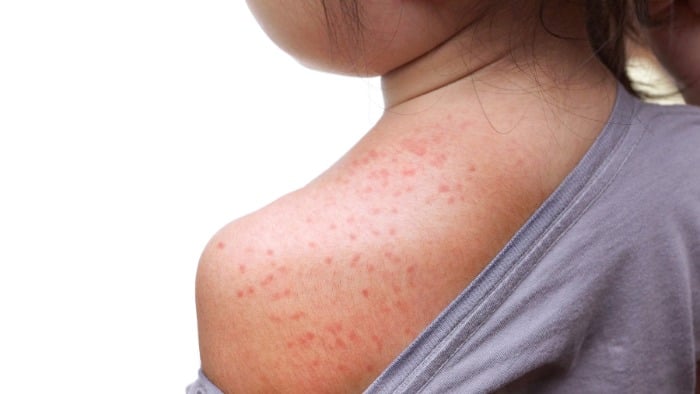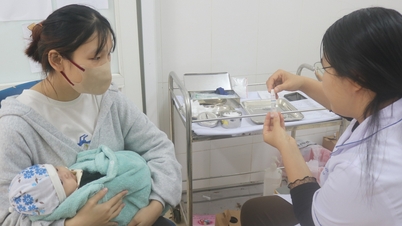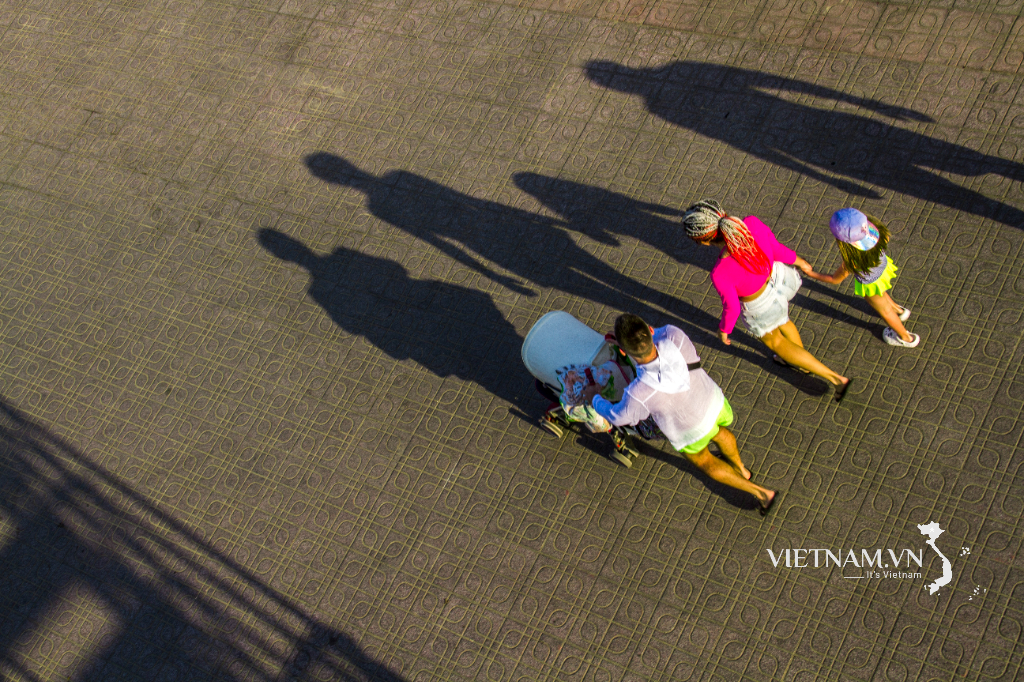A girl has a high fever and a red rash all over her body due to a dangerous infectious disease that often occurs in winter and spring.
A girl has a high fever and a red rash all over her body due to a dangerous infectious disease that often occurs in winter and spring.
NLDC girl (14 years old, Hanoi ) came to Medlatec Thanh Xuan General Clinic with symptoms of high fever and red rash all over the body.
 |
| Illustration photo. |
Dr. Tran Thi Kim Ngoc, a pediatrician at Medlatec, said that after examination, the doctor found that the baby had a high fever, runny nose, and a maculopapular rash. The rash developed in order from the back of the neck, forehead, face, and neck, then gradually spread to the trunk and limbs.
Taking a medical history, the family said that before coming to the clinic, the child had a high fever of 39 degrees, accompanied by chills and a sore throat. Afterwards, a red rash appeared scattered behind the ears and face and spread all over the body.
The family took the child to a private clinic specializing in Ear - Nose - Throat, with a negative 5-agent flu test result and a diagnosis of acute streptococcal pharyngitis, and prescribed outpatient medication.
However, on the third day of the illness, baby C. started to have a fever of over 41 degrees, fatigue and a rash on his face. The family was worried and decided to take the baby to Medlatec Thanh Xuan for further examination. With these clinical symptoms, Dr. Ngoc suspected that the baby had measles or dengue fever and ordered paraclinical tests for diagnosis.
The test results showed that other indicators were normal, but the measles IgM test was positive. Therefore, the doctor diagnosed the child with measles rash fever, prescribed outpatient treatment and scheduled a daily follow-up appointment. The doctor also instructed relatives on how to care for and supplement the child's nutrition.
After using the medication, the girl's symptoms gradually decreased each day. The family took her back to Medlatec Thanh Xuan for a follow-up examination. By the 7th day, the fever had gone down, the rash had disappeared, and there were no more clinical symptoms. The girl's general condition was stable.
Measles is a contagious respiratory disease caused by the measles virus. This disease usually occurs in winter and spring, mainly in children under 5 years old.
The measles virus can survive in the air and on surfaces for up to 2 hours, and a person with measles can infect 9-10 unvaccinated close contacts. The highest risk of infection is 4 days before and 4 days after the rash appears.
Associate Professor, Dr. Nguyen Thai Son, a microbiologist at Medlatec Healthcare System, said that the measles virus has a very strong ability to suppress the immune system. People with measles are at high risk of complications in the respiratory system, brain, heart muscle, and the mortality rate is also very high.
Therefore, measles vaccine is an important preventive measure widely recommended by the World Health Organization and many countries.
Since the measles vaccine was introduced in Vietnam in 1985, the incidence of the disease in children has decreased significantly. However, recently, measles has returned, not only in children but also in adults, with many serious cases. The reason is that some people do not get vaccinated or do not get enough doses, or because mothers do not get vaccinated, causing their children to be born without immunity and susceptible to the disease.
According to Associate Professor, Dr. Son, the latest recommendation states that in high-risk areas, measles vaccine can be given to children from 9 months of age. The current vaccination system also recommends 2 doses: Dose 1 at 9 months of age and dose 2 at 18 months of age, and the third dose can be given at 4-6 years of age. Getting all 3 doses will help children have lifelong immunity.
For the girl in the story above, although she had received a single measles shot and a MR (measles-rubella) shot, she had not received a booster shot. Therefore, she had an immune gap, leading to a weakened ability to protect her body against the measles virus. Medlatec doctors recommended that her family get vaccinated against measles to prevent the disease.
Experts also share ways to prevent measles after contracting it: Get enough rest, eat a nutritious diet, treat infections immediately, especially respiratory infections, gargle regularly and drink enough water to help eliminate the virus. The community also needs to isolate sick people to limit the spread, wear masks when going out, and limit gatherings in closed places.
Currently, the Ministry of Health recommends two main methods for diagnosing measles: IgM test, detecting IgM antibodies in serum, best performed from the third day after the rash appears; and PCR test on respiratory secretions, best from nasopharyngeal or throat secretions within the first three days of illness.
After day 5, the sensitivity of the PCR method decreases and is not recommended after day 10. Both IgM and PCR testing methods are widely performed at all Medlatec Healthcare System facilities.
According to the World Health Organization (WHO), the monovalent measles vaccine can be given to children from 6 months to under 9 months of age during epidemics as a measure to strengthen epidemic prevention. This vaccine is considered as the "measles 0" dose and then the child continues to be vaccinated with 2 doses of measles vaccine according to the schedule of the expanded immunization program at 9 months and 18 months of age.
It is known that WHO has sent a document to the Ministry of Health agreeing to add 260,000 doses of measles vaccine for children aged 6 to under 9 months. The Ministry of Health is completing procedures to confirm the aid source to allocate to the provinces that have proposed, thereby promptly vaccinating these young people.
To control the epidemic, the Hanoi CDC recommends that people, especially families with young children, should follow the measles vaccination schedule. Children from 9 months old need to get the first dose of vaccine, the second dose at 15-18 months and the third dose when the child is 4-6 years old. For children at high risk or living in epidemic areas, early vaccination from 6 months of age can be considered.
Health experts emphasize that vaccination not only helps protect children's health but also helps prevent the spread in the community.
Dr. Nguyen Tuan Hai, Safpo/Potec Vaccination System, said that vaccination is the only way to protect children and adults from this potentially dangerous disease. Countries around the world are required to achieve and maintain a coverage rate of over 95% with 2 doses of measles vaccine.
Children and adults need to proactively get fully and timely vaccinated against measles to help the body produce specific antibodies against the measles virus, helping to prevent the risk of measles and severe complications, with outstanding effectiveness of up to 98%.
In addition, each person needs to proactively clean their eyes, nose, and throat every day, improve their nutrition, and supplement essential vitamins and minerals to improve their body's resistance and natural immune system. These measures will help reduce the risk of measles and other infectious diseases, especially in the winter and spring.
Source: https://baodautu.vn/soi---benh-truyen-nhiem-nguy-hiem-vao-mua-dong-xuan-d250998.html





































![[Photo] President Luong Cuong receives President of the Cuban National Assembly Esteban Lazo Hernandez](https://vphoto.vietnam.vn/thumb/1200x675/vietnam/resource/IMAGE/2025/9/30/4d38932911c24f6ea1936252bd5427fa)
![[Photo] Panorama of the cable-stayed bridge, the final bottleneck of the Ben Luc-Long Thanh expressway](https://vphoto.vietnam.vn/thumb/1200x675/vietnam/resource/IMAGE/2025/9/30/391fdf21025541d6b2f092e49a17243f)
![[Photo] Solemn opening of the 12th Military Party Congress for the 2025-2030 term](https://vphoto.vietnam.vn/thumb/1200x675/vietnam/resource/IMAGE/2025/9/30/2cd383b3130d41a1a4b5ace0d5eb989d)
![[Photo] The 1st Congress of Phu Tho Provincial Party Committee, term 2025-2030](https://vphoto.vietnam.vn/thumb/1200x675/vietnam/resource/IMAGE/2025/9/30/1507da06216649bba8a1ce6251816820)





























































Comment (0)